- Story of author’s, born Tamilian, spiritual connect with Baba Siri Chand, His Life and Teachings and Babaji’s interaction with various Sikh Gurus.
This is a topic of much trepidation. Though I feel humbled and
inadequate to broach this topic, I write purely out of my love and reverence
for this great Yogi and mean no disrespect to any other beliefs that may be
held by others.
As usual my interpretation is based on personal experiences and I look
for no validation. My intention is neither to offend nor refute, nor to please
anyone. Enjoy this writing as a heartfelt tribute to the glorious being called
Baba Siri Chand, son of Guru Nanak Devji and Mata Sulakhani (or Sulakshana
Devi).
A Personal Note
My association in this life with Baba Sri Chand started as a remembrance
of a flavour, a fragrance, a remnant from the past that flowed and could be
savoured in the present. A difficult morsel to chew for many, but the fact
remains that in the Indic thought of birth and rebirth, it firmly understands
that the soul is reincarnated in every life to complete past life karmas.
It was early morning on a full moon day in April 2002. I got up in the
wee hours and went to my newly constructed temple studio to meditate. The full
moon was shining through the large window looking almost as if I could reach
out and touch it. As I went in and out of my deep sadhana my eyes opened and lo
I saw this face forming in the moon and emerging out of it.
Though not associated in any way with the Udasis in this life, I
immediately identified the vision as that of Baba Siri Chand, a figure of no
immediate connection at that time. Smiling gently he silently communicated that
I should visit his akhara that day itself……I had a lot of appointments planned
for that day so I asked if I could come next day? At this, he smiled gently and
disappeared back into the moon.
Of course, I dropped everything and after making enquiries, made my way
to Kiratpur, the only place connected with Baba Siri Chand that I could find
out about at that point of time. Later I got to know that the sacred ground breaking
ceremony for this city was done by Baba Siri Chand and the Gurudwara I visited
was established by Baba Guruditta, son of Guru Hargobind Ji (sixth Guru
1595-1644).
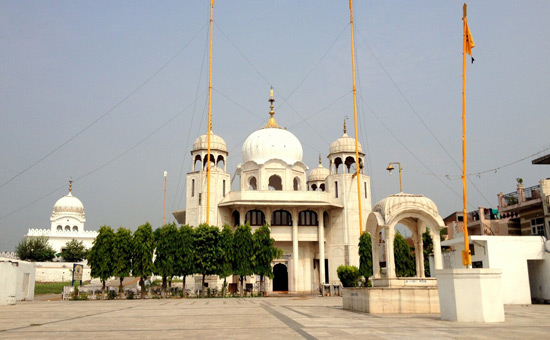 Kiratpur Sheesh Mahal Gurudwara.
Kiratpur Sheesh Mahal Gurudwara.
It was with a wonderful sense of homecoming that I entered the very
simple premises of this sacred place. Unlike most Gurudwaras I had visited,
this one was very unostentatious and basic. At that time I did not know the
significance of this Gurudwara called Gurudwara Sheesh Mahal.
While being summoned by Baba Siri Chand appearing in the full moon, he
had asked me to bring, as an offering, a shawl I had bought for my Guru Yogiraj
Siddhanath whom I was to meet later in the month at his ashram near Pune,
Maharashtra. So I had carried it with me and very reverentially offered it at
the darbar sahib and the kind Sikh Udasi there helped me to unfold and lay it
on the platform besides the granth. I then went and sat at the Dhuni for a
while before heading back to Chandigarh.
This first contact led to a realisation later of past interactions with
this evolved being from the time of the sixth Guru, Guru Hargobind Ji also
known as Sachhe Patshah, and which mystically led me to discover a
gurudwara in Sector 39, Chandigarh ie dedicated to and associated with Baba
Siri Chand; and which was also, as was revealed to me, used as an army camp by
Guru Hargobind, instrumental in preparing soldiers for the coming resistance to
the then ruling Mughals.
Baba Siri Chand 1494- Early Life
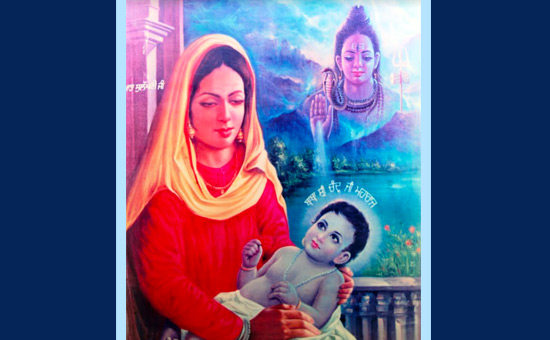
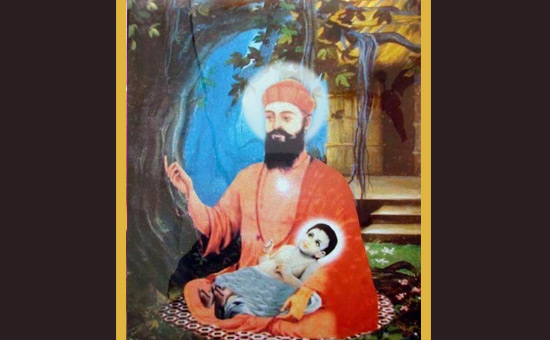
Siri Chand was born in the year 1494, his birthday is recorded as the
8th of September.
It is believed by his devotees that Mata Sulakhani had a vision of
Mahadev Shiva while carrying Siri Chand in the womb. Also remembered is the
recounting of Nanak’s meeting and debate with the Siddhas in the Siddha
Goshti. Here he is said to have defeated Guru Gorakhnath who then told
him he will take birth in the Nanak household as his son. Hence, many believe
Siri Chand to be an incarnation of Gorakhnath.
According to local tradition, baby Siri Chand was born with natural
flesh mundra in his ears, matted locks and ash smeared body, giving additional
credence to his connection with the lineage of Guru Gorakhnath.
What warms my heart is the fact that Nanak recognised and respected the
interests of his son and instead of forcing him to follow in his footsteps,
gave his blessings and sent him for training on his chosen path.
The adolescent Siri Chand excelled in yogic practice and is
today recognised as the founder of the ascetic Udasi sect. Not much is known
about him except that he continued to blossom and along with yogic practices
spread awareness of his father Guru Nanak Devji’s teachings.
According to Dr Satish Kapoorji, noted educationist, historian and
spiritualist, “Siri Chand was invested with yajnopavita (sacred
thread) and formally initiated into Vedic literature by Pandit Hardayal. At 11,
he went to the gurukul of Acharya Purushottama Kaul in Srinagar for a
comprehensive study of religious texts, and subsequently received initiation
from Avinash Muni.” Source The Tribune.
It is interesting to note that Guru Nanak himself a Bedi (from Vedi for
those who can orally recite entirely one Veda), rebelled against the wearing of
this sacred thread yet initiated his son into this ceremony. For me this
reiterates my understanding that Sat Gurus guide each one according to their
own nature, to follow the path to the divine. The rigidity is mostly brought in
by subsequent followers.
His Teachings
The travels of Guru Nanak Devji are called Udasis. It is believed, by
followers of Baba Siri Chand, that when his father Guru Nanak returned from his
travel, after every Udasi he would bless his son by giving him the choga (long
dress or cloak) that he carried during his journey. In a way entrusting Baba
Siri Chand with the responsibility of continuing the Udasi
Sampradaya. Guru Nanak Devji also gave him the satnam of Ik Onkar Satnaam, Wahe Guru as
jaap.
Udasis are also known as Nanakputra, sons of Nanak. Many
consider the Udasis to be the original and genuine followers of Guru Nanak, who
they believe to be the founder of the Udasi. The word Udasi itself is derived
from the word udas as in sad, meaning one is sad until the final merging in the
divine, Parmatma.
The most known works of Baba Siri Chand are the Arta Sri Guru
Nanak Dev, an Aarti for Guru Nanak and the Matras a
presentation of the Udasi philosophy.
What I first learnt about the activities in a Gurudwara dedicated to
Baba Siri Chand was from the historical (for me) Gurudwara I visit in
Chandigarh. This place is looked after by followers of Maharaj Virsa Singh of
Gobind Sadan, Delhi.
They mostly study and read the Jaap Sahib (written by Guru Gobind
Singhji) around the Dhuni as they do the havan, the Ardas in
the darbar sahib where the Guru Granth Sahib is kept, is the same as in
traditional Sikh Gurudwaras. This is followed by a special tribute to Guru
Gobind Singhji; also performed is an aarti of Baba Sri Chand and the aarati of
Guru Nanak Devji as written by his son Baba Siri Chand. Along with this is
recited the Matri of Baba Siri Chandji, Guru Gobind
Singh’s Chandi di vaar and the Hanuman Chalisa.
(Note that the late Maharaj Virsa Singh did not adhere to what is considered
mainstream Sikhism today and the activities of this Gurudwara reflect that and
are more inclusive including celebrating Christmas).
It was only when I visited the Baba Siri Chand Akhara in Amritsar that I
came to know more of the yogic practices taught by Baba Siri Chand to the Udasi
sect. It involved advance Pranayam, Kumbhak and Chakra Bhedan, activation of
Kundalini through thokar (thokar is called Chakra Bhedan in Kundalini Yoga).
These are very similar to the practices I do in this life. I was
initiated into them by Satguru Yogiraj Siddhanath, who highly reveres and
constantly educates his disciples about Baba Siri Chand whom he calls Yogi Shri
Chandra. On his visits to Chandigarh he always takes time out to visit the Baba
Siri Chand Gurudwara mentioned above.
It is tragic that not much is available in written form about the yogic
teachings of Baba Siri Chand. The books I found on my first visit to Amritsar
were no longer available on my subsequent visits.
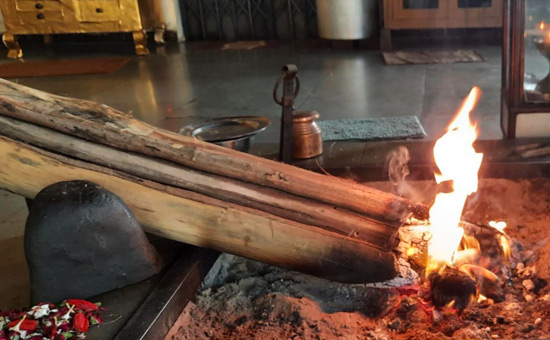 Dhuni at the Baba Siri Chand Gurudwara in
Sector 39, Chandigarh.
Dhuni at the Baba Siri Chand Gurudwara in
Sector 39, Chandigarh.
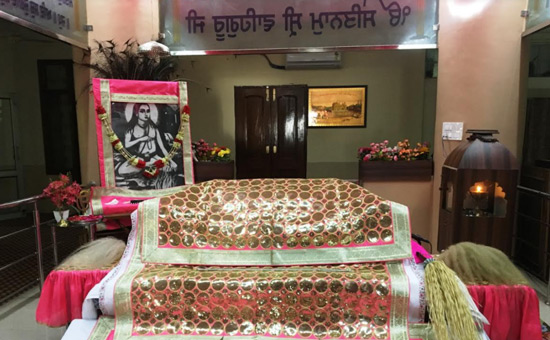 The Adi Granth in the sanctum sanctorum
of the Sector 39 Gurudwara.
The Adi Granth in the sanctum sanctorum
of the Sector 39 Gurudwara.
In most gurudwaras of Baba Siri Chand, called Akharas as in the Nath
language one will find the Guru Granth Sahib enshrined within the sanctum
sanctorum and the Dhuni fire with the chimta (fire tong) of the Nath yogis on
the outside. Udasis are known for lighting Dhuna or fire that burns continuously, a
tradition followed since ancient times by the Gorakhpanthis of
the Nath order.
For me, this combination of the Adi Granth and the Dhuni is a lesson on
how while being a householder one can also be detached like ascetic yogis. The
true confluence of both and a river I seem to be floating down from past
lives.
Baba Siri Chand and the Sikh Gurus
Baba Siri Chand was extremely revered by the subsequent successors of
his father. Few incidents stand out. I recount them here as recited to me by
devotees.
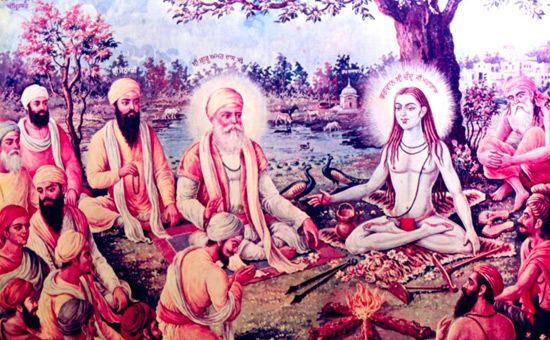 Guru Amardas with Baba Siri Chand.
Guru Amardas with Baba Siri Chand.
When Guru Amardas (third Guru 1479-1574) met him he recited the Anand
Sahib joyously. He offered Baba Siri Chand his son Mohanji. Baba Siri Chand in
turn entrusted Mohanji with the handwritten pothi - notes of Guru Nanak
Devji which were later compiled by Guru Arjan Dev into the Adi Granth.
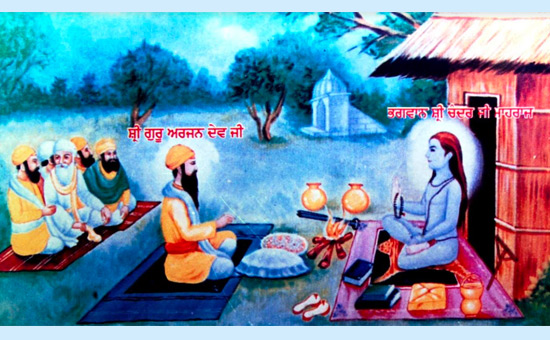 Guru Arjan Dev and Baba Siri Chand in Taran
Taaran.
Guru Arjan Dev and Baba Siri Chand in Taran
Taaran.
When Guru Arjun Dev (fifth Guru 1563-1606) went to meet Baba Siri Chand
at Barth Sahib, he had to wait many days as Siri Chand was deep in meditation.
At that meeting, after naming the Taran Taaran sarovar, Baba Siri
Chand poured water from his holy pot and blessed the lake to never dry up and
imbued it with healing properties.
To this day devotees come to take snaan
in this sarovar to heal themselves and to be blessed. Later when Baba Siri
Chand visited Amritsar, Guru Arjun Devji was composing the Sukhmani Sahib and
had got stuck at sixteen verses. Then Baba Siri Chand gave him a new impetus to
complete by reciting the shlok- Aad sach, jugaad sach, hai bhi sach,
nanak hosee bhi sach, meaning True in the beginning, true throughout the
ages, true in the Now, Nanak forever True.
One of Baba Siri Chand's feats I heard about talks of how when Guru Arjan Dev was made to sit on a hot tawa and when hot sand was being poured over him, Sitting far away in his dera, Baba
Siri Chand had his disciples pour water on a sapling, the water steamed and
boiled as it was poured and devotees believe that gave relief to Guru Arjan’s
suffering.
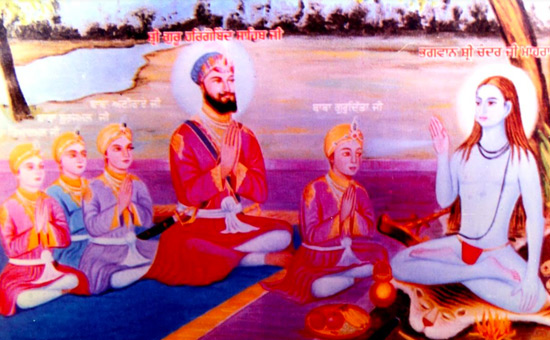 Guru Hargobind Ji offers his son Guruditta to Baba Siri Chand
Guru Hargobind Ji offers his son Guruditta to Baba Siri Chand
Guru Hargobind Ji (sixth Guru 1595-1644) went to take blessings from
Baba Siri Chand and he too gave his son, since then to be known as Guruditta,
given by the Guru or to the Guru is an interpretation open to the follower.
Guru Hargobind was instrumental in carrying forward the instructions of
his father to start preparing an army of steady soldiers for the coming
onslaught. This is the period of my connection with both Baba Siri Chand as
spiritual Guru and Guru Hargobind as militant Guru. His instructions of Miri and Piri,
temporal and spiritual swords, have been carried forward, resonating very
deeply with my practice in this life too.
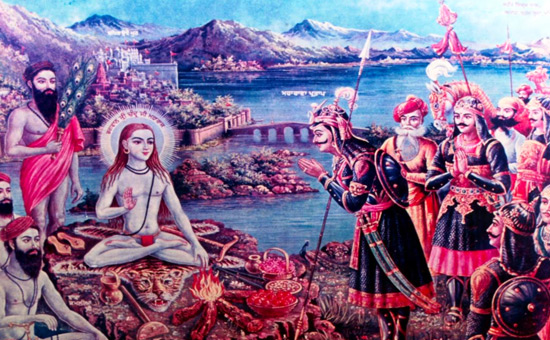 Maharana Pratap offering respect to Baba Siri Chand.
Maharana Pratap offering respect to Baba Siri Chand.
Besides the Guru’s other great emperors also came to meet Baba Siri
Chand. One such person was Maharana Pratap, who came to seek his blessings in
Udaipur when Babaji was visiting the city. It is said that Emperor Jahangir
sent his personal elephant with his soldiers to escort Baba Siri Chand to his
court but the elephant could not even lift his blanket. This way Babaji sent
the emperor a lesson on ego.
Teachings through Miracles
For me miracles is a science, acting faster than the human brain can
comprehend so they seem unexplainable to the ordinary mind. To bend and
override laws of nature to their will seems to be an act of child’s play and
our Gurus’s lives are full of such acts which they apparently accomplished with
no effort. Importantly, most of these miracles are to teach lessons in
humility, compassion and courage to those witnessing them.
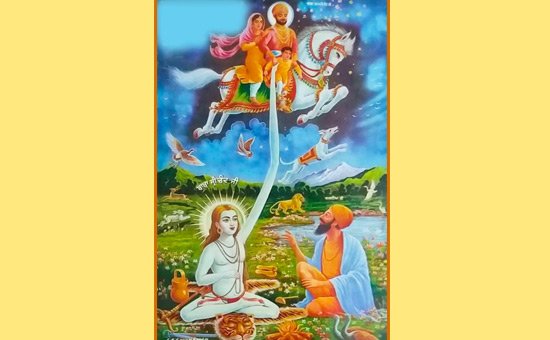 Baba Siri Chand reaches out to pluck Dharam Chand and bring him back to earth.
Baba Siri Chand reaches out to pluck Dharam Chand and bring him back to earth.
In a very dramatic story, Baba Siri Chand is depicted reaching out with
a long arm reclaiming his nephew Dharam Chand from his brother Lakshmi Chand as
he and his wife leave for their heavenly abode apparently as penance for
killing animals during shikar. He does this out of compassion to save the
lineage of his father Guru Nanak.
Later he is shown feeding the hungry baby milk from his big toe, thus
completing the role of father and mother. Which for me was a lesson in showing
the presence of both male and female energy in this great evolved being. He
went on to teach how the discriminations in gender is created by humans and has
no relevance in the realm of the divine.
When once Yakub Khan, Governor of Kashmir went to meet him full of
anger, ready to trample the area underfoot Baba Siri Chand calmly picked up a
burning log of fire from the dhuni and planted it firmly on the ground, and lo
behold it sprouted leaves and came alive again.
Once again by a simple act Siri Chand taught a lesson to Yakub Khan on how
anger harms and burns one to ashes and how by overcoming it new life can be
born and immediately calmed him.
There are many other incidents of Baba Siri Chand - bringing forth fresh
water by the seaside, bringing dead animals and people alive, bestowing
longevity, stilling the storm to guide ships of a merchant devotee and such are
the legends of great beings in India.
It is believed that the great Siddhas came to hear his discourses and
see the miracles he did with so much ease. The beauty of these oral traditions
are that we get the flavour of the land and the people. For me that is an
invaluable ingredient in savouring them.
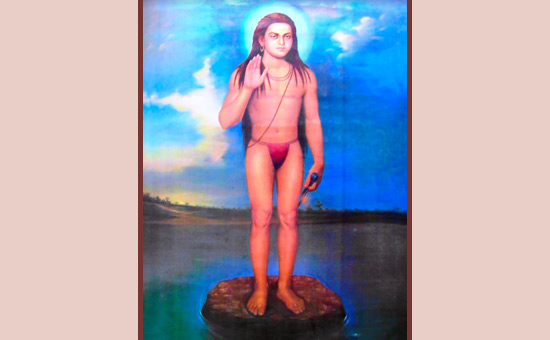 Baba Siri Chand crossing river Ravi on a boulder.
Baba Siri Chand crossing river Ravi on a boulder.
Finally on a day in 1643, nearing his the 150th birthday, Baba Siri
Chand is believed to have mounted a boulder and crossed over to the other side
of river Ravi. He disappeared from mortal eyes after having promised his
disciples that wherever a dhuni is lit, there he will be present. And so to
this day the dhuni is lit and kept alive in the Gurudwara Akharas dedicated to
him across this country, and his presence felt by the sadhaks sitting around
this sacred fire.
Author
is a Chandigarh based Kriyacharya. Pictures
in article clicked by author, are of Baba Sri Chand Gurudwara, Sector 39 Chandigarh.
To read all
articles by author